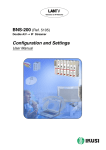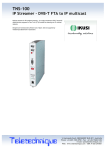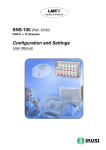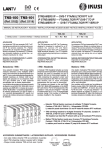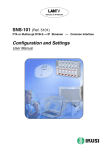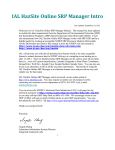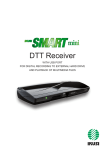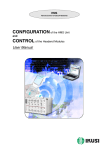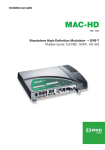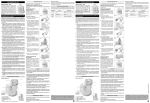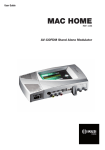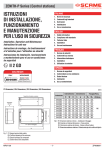Download BNS-200 IPTV Streamer – Dual AV to IP multicast
Transcript
BNS-200 IPTV Streamer – Dual AV to IP multicast Multicast streamer for IP broadband networks. Two channels of composite video with stereo audio encoded for IP streaming over IP multicast networks. Designed and manufactured by Messrs Ikusi of Spain. Sold and supported by Teletechnique Beechmont in Queensland. 14 Jacaranda Court, BEECHMONT QLD 4211, Australia Phone: +61-(0)7-3103-0750 - Fax: +61-(0)7-5604-1402 E-mail: [email protected] Web: www.teletechnique.com - ABN 34 383 278 861 Data Sheet V/A to IP Streaming Equipment BNS200 REF. 5105 JJ JJ JJ JJ JJ JJ JJ Double V/A to IP Stramer. Output: 1 or 2 IP-encapsulated TV broadcasts with individualJ multicast addresses. Filtering of information contained in the MPEG-2 tables. UDP and RTP transmission protocols. Web interface for module configuration. Alarm information SNMP agent. SAP and SDP protocols to facilitate automatic programme selection in the set-top box and to provide programme information to external servers. BNS-200 (2x) VideoJ (CVBS - PAL, SECAM, NTSC), (2x) AudioJ (ANALOGUE - Mono, ST/Dual) Inputs A/V inputs Input Section (V/A) Video input level Video input impedance Vpp (2x) 0.7 – 1.4 Ω (2x) 75 (2x) 0.5 – 4.0 Ω (2x) > 600 PAL: 720 x 576, NTSC: 720 x 480 Vpp Max video resolution Audio input impedance Audio input level Yes SNMP support - traps Codificación MPEG Video coding MPEG-2 MP&ML, MPEG-4 ASP Audio coding MPEG-1 Layer II Ethernet switch Output Section (IP) Standard Bit rate IP NET IEEE 802.3 10/100 Base T Mbps up to 100 Transmission protocols UDP/RTP No. of simultaneous streams 2 Multicast Yes J Connectors Video connection (2x) female RCA Audio connection (4x) female RCA DC connection — Ejemplo de cabecera mixta BNS/SNS para cuatro fuentes locales audio/vídeo y seis transpondedores TV satélite digital. Contiene 2 BNS-200, 6 SNS-102 y 1 alimentador CFP-500, instalados todos ellos en 1 base-soporte BAS-900. Esta estación puede suministrar a la red IP hasta 48 cadenas TV (8 cadenas por streamer SNS) más 4 emisiones locales TV (2 de sonido mono y 2 sonido estéreo). banana socket Configuration RS 232/DB-9 Ethernet output RJ-45 J General Supply voltage Vdc Consumption mA Indicator LEDs +12 640 ON - STATUS - LINK - ACT Operating temperature °C 0 – +45 Dimensions mm 230 x 195 x 32 The module is packed with: - 1 DC plug bridge, 53 mm length, for connection of +12 Vdc voltage. Ángel Iglesias, S.A. Paseo Miramón, 170 20009 San Sebastián, Spain Tel. +34 943 44 88 00 Fax +34 943 44 88 20 [email protected] www.ikusi.com Television on IP Networks BNS-200 (Ref. 5105) Double A/V ➞ IP Streamer Configuration and Settings User Manual EN Configuration and Setting of the BNS-200 Streamer Module User Manual November 2008 Revision A IKUSI - Ángel Iglesias, S.A. Paseo Miramón, 170 20009 San Sebastián SPAIN Tel.: +34 943 44 88 00 Fax: +34 943 44 88 11 www.ikusi.com CONTENTS Introduction ............................................................................................................................. 4 This Manual ................................................................................................................. 4 Product Description ...................................................................................................... 4 Chapter One - Configuration of the BNS-200 Streamer ......................................................... 5 Configuration ........................................................................................................... 6-10 Save/Restore Configuration ....................................................................................... 11 General Report .......................................................................................................... 12 Chapter Two - BNS-200 Streamer Settings .......................................................................... 13 Input Settings ........................................................................................................ 14/15 Coding Settings ..................................................................................................... 16/17 Output Settings ..................................................................................................... 18/19 SAP/SDP Channel Settings ....................................................................................... 20 SNMP Configuration ............................................................................................. 21/22 Chapter Three - BNS-200 Streamer Status Information ....................................................... 23 Status Information ...................................................................................................... 24 Chapter Four - BNS-200 Streamer Reports .......................................................................... 25 Output Streams .......................................................................................................... 26 System Logs .............................................................................................................. 27 3 Introduction This Manual This manual describes the configuration and settings programme for the BNS-200 Streamer Module. It is the second part of the user documentation for said module, the first part of which is the Installation and Access manual supplied in paper format. Product Description BNS-200 streamers are A/V to IP gateways designed to broadcast in multicast on an IP network the TV broadcasts issued from video and audio local sources. The IP streams can be viewed using an IPTV settop box or a software video player. BNS-200 modules have an IKUSI ClassA mechanical format. As such, they are fixed to BAS-700 / BAS-900 baseplates or to an SMR-601 rack frame, and are +12 VDC powered from a CFP module. Characteristics ● ● ● ● ● Output: 1 or 2 IP-encapsulated TV broadcasts with individual multicast addresses. UDP & RTP transmission protocols. Web interface for configuration and setting. Alarm information SNMP agent. SAP & SDP protocols that facilitate automatic service selection on the user's STB and provide information to external servers. ADVANCED Configurable QoS marking Configurable Time To Live When the connection is established between the BNS-200 streamer and the control PC, the programme access screen appears: Programme Access Screen Once the desired programme language has been chosen [ English (en), Spanish (es), French (fr) ], enter the password and click on OK. Note: The default password — admin — can (and must) be changed as explained on page 9. 4 Chapter One - Configuration of the BNS-200 Streamer In this Chapter ● Configuration ● Save/Restore ● General Report 5 Configuration General Configuration Initial program screen The first screen that appears when the programme is accessed contains the "Output" window, which gives information on the IP streams that have been created on the module and which may or may not be incorporated into the output data stream. On the left of this screen are the menus that access all of the programme's functionalities. Figure 1.1 - Initial programme screen Click on the General menu on the left of the screen to display a dropdown list containing the 3 options: Configuration, Save/Restore and General Report. Click on Configuration. The Configuration window will appear : Figure 1.2 - Identification card of the Configuration window. Identification The identification card (Figure 1.2) provides basic data on the BNS-200 streamer. The different card fields are completed as follows: 6 Configuration "Model": BNS-200. This data cannot be changed. "Serial Number": Informational data which cannot be changed. "Firmware Version": As above. "Identifier": Any name that the installer or operator wishes to assign to the streamer module can be entered here. "Location": Enter the postcode of the installation site if required. "Installer": The installer's identification details can be entered here. "Contact": Then enter their contact details (telephone number, email). "Installation date": The date on which the streamer module was installed can be entered here. Click on the Save button at the bottom of the window to store the information on the streamer module, this information is then shown each time the module is accessed. 7 Configuration Network Click on the Network tab to configure the streamer's ethernet connection parameters. The following card is displayed: Figure 1.3 - Network card of the Configuration window. "Use DHCP to get IP address": If this box is checked, the BNS-200 module will use the DHCP protocol for assigning dynamic IP addresses. Consequently, no data needs to be entered in the next five fields on the tab. If the administrator of the network on which the BNS headend is installed assigns static IP addresses, the box will not be checked and the following fields will need to be filled in. WARNING: If this option is activated, the IP address assigned to the streamer can only be known by consulting the DHCP server management system. "IP Address": Enter the IP address that you wish to assign to the streamer. This address must fall within the range of local network addresses. "Network mask": Enter the local network mask. "Default gateway": Enter the IP address of this gateway. This information is only required if you want the streamer to access Internet. "Primary DNS server": Enter the primary server's IP address. Equally, this information is only required if you want the streamer to access Internet. "Secondary DNS server": Enter the same information for the secondary server. "MAC Address": The physical address of the streamer's ethernet network card is displayed automatically. Once you have filled in all of the required information, click on Modify Network Configuration. If, at the last moment, you decide to keep the current settings, click on Restore. 8 Configuration Password If you want to change the current access password, click on the Password tab. The following card is displayed: Figure 1.4 - Password card of the Configuration window. "Current password": Enter the current password. "New password": Enter the new password which will be required to access the program the next time. "Confirm new password": Re-enter the new password. Once you have entered the required information, click on Modify so that the streamer adopts the new access password. If, at the last moment, you decide to keep the previous password, click on Cancel. ! Note If you do not know the old password, i.e. the password used to access the current configuration session, you must perform a Password Reset as explained in the Installation and Access manual. Following this reset, the program password will be the default password: admin. IMPORTANT: When you perform a password reset, the IP address assigned to the streamer on the Network card (previous page) automatically changes to the default setting: http:// 92.168.1.4. Shutdown If you need to reboot the streamer for any reason, click on the Shutdown tab. The following card is displayed: Figure 1.5 - Shutdown card of the Configuration window. Click on Reboot. A reset is then performed after which the Output Streams screen will appear, this is the presentation screen of the programme. 9 Configuration Update Firmware If you wish to update the streamer's firmware, click on the Update Firmware tab. The card displayed (Figure 1.6) shows the firmware version that the streamer has at the present time. (The firmware is software stored in the module which is responsible for its basic operation). Figure 1.6 - Update Firmware card of the Configuration window. WARNING: The firmware update file will have been previously stored on the PC hard drive. (You can download it from http://www.ikusi.com). Click on Browse... and select the firmware update file from the hard drive. When the file name is in the box, click on Start. The new firmware will be installed on the streamer and then its name will appear in the card replacing the one of the file before. 10 Save/Restore Save/Restore System Settings All of the data established on the streamer module through the various Configuration window tabs can be saved onto a backup file. Inversely, the configuration data saved on an appropriate file can be restored on streamer module. Click on the General menu on the left of the general programme screen and click again on the Save/Restore option. The Save/Restore window will appear: Figure 1.7 - Save/Restore window Save/Restore Configuration "Save configuration": Select the option in the window and click on Start. A window is displayed which allows you to select the destination folder for the data file for the current streamer configuration. "Restore Configuration": Select this option in the Save/Restore window (Figure 1.7) and click on Start. The Restore Configuration window is displayed (Fig. 1.8) Click on Browse... and select the file containing the configuration data that you wish to restore on the streamer module. Once you have selected the file, click on the Upload File button at the bottom of the screen. The upload confirmation window will be displayed. Figure 1.8 - Restore Configuration Window 11 General Report General Report Click on the General menu on the left of the general programme screen and click again on the General Report option. The General Report window is displayed: Figure 1.9 - General Report window This window provides complete information on the BNS-200 module, not only regarding the configuration described in the previous pages, but also in relation to the current settings parameter values and operational status. The information contained in this window can be printed by clicking on the Print page button at the bottom of the screen. 12 Chapter Two - BNS-200 Streamer Settings In this Chapter ● Input Section Settings ● Coding Section Settings ● Output Section Settings ● SAP/SDP Channel Settings ● SNMP Configuration 13 Input Input Section Settings The BNS-200 module settings are grouped into five sections or categories: Input, Coding, Output, SAP/SDP Channel and SNMP. Click on the Settings menu on the left side of the general programme screen. A drop down list is displayed offering four options: Input, Coding, Output, SAP/SDP Channel and SNMP. Click on Input. The Input window will appear: Figure 2.1 - Input window This window presents two identical sections related to each one of the two input sections of the BNS-200. The window informs first about existence of A/V input signals: "Video" : Indicates whether there is or not video signal (CVBS — composite video). A ✓ mark indicates existence of signal, and a cross ✖ does absence. "Audio" : Idem audio signal (analogue). "Colour System" : Informates about the colour system of the video signal (PAL, SECAM or NTSC). The window presents below different setting fields related to the digitalisation of the video signal. The two last ones (TV Filter and Field Order) only appear if the Advanced Configuration box at the upper part of the window is checked. "Brightness" : Increment buttons for setting the brightness you want to confer to the digitalized video signal. The box at right shows a reference figure whose by default value is 128. "Contrast" : Idem for setting the contrast. By default figure: 66. "Saturation" : Idem for setting the colour saturation. By default figure : 63. 14 Input "Sharpness" : Select from the drop down list the sharpness you want to confer to the digitalized video signal: None, Low, Medium or High. "TV Filter" : Idem the type of video filtering in the digitalisation processing: Deactivated, Spatial NR (noise reduction), Temporal NR, Noise Filter, Comb Filter. "Field Order" : Idem the field of the input video signal that will be the first (dominant) in the output stream. The Top Field First option selects as first field the one that includes the first line of the screen, and the Bottom Field First option selects as first field the other. The By Default button at the lower part of the window allows to restore all the settings and selections to the by default values. Once you have done all the settings and selections in the two sections of the window, click on the Save button to conclude the Input settings of the BNS-200. 15 Input Coding Settings Click on the Settings menu on the left of the general programme screen and then click on Coding. The Coding window will appear : Figure 2.2 - Coding window This window has two identical cards, Input 1 and input 2, related to the two input sections of the BNS-200. Each card has 4 sections —Video, MPEG4, Audio and DVBTS—, where one can configure the MPEG coding of the input video/audio signals and the related DVB transport stream. Video Section : "Coding" : Select from the drop down list the coding standard: MPEG2 or MPEG4 ASP. "Rate Control Mode" : Idem the control mode of the stream bitrate: Unlimited BitRate or Limited BitRate. When selecting "unlimited", the Average BitRate field appears below. Idem "limited", the Max BitRate field. "Average BitRate" : Slide icon for setting the average output bitrate of the MPEG coder. The highest and lowest values of the operating bitrate will be able to amount to +50% and -50% respectively of the entered value. "Max BitRate" : The entered value will not be surpassed at any time. "Resolution" : Select from the drop down list the resolution for the digitalized video signal. The available options are the following: - CIF 176x144 - 2CIF 352x288 - HalfD1 NTSC 352x480 ó PAL/SECAM 352x576 - 4CIF NTSC 704x480 ó PAL/SECAM 704x576 - D1 NTSC 720x480 ó PAL/SECAM 720x576 "Aspect Ratio" : Select from the drop down list the aspect ratio for the digitalized video signal: 1:1, 4:3 or 16:9. 16 Input "Frame Rate" : Idem the frame rate. The options are the following: - 12fps PAL MPEG4 only - 15fps NTSC MPEG4 only - 25fps PAL MPEG2/MPEG4 - 30fps NTSC MPEG2/MPEG4 - 50fps PAL MPEG2 only - 60fps NTSC MPEG2 only "Number of B images in GOP" : Select from the drop down list the number of B ("Bi-directional") images within the GOP ("group of pictures"). "Number of P images in GOP" : Idem the number of P ("Predicted") images. MPEG4 Section : "Profile" : Two options : SP (Simple Profile) or ASP (Advanced Simple Profile). Select the desired one from the drop down list. "Level" : Six options : Level 0 to Level 5. "Quantization" : 2 options: QUANTTYPE 0 and QUANTTYPE 1. Audio Section : "Format" : Select from the drop down list the standard of the audio signal coding : MP1 Layer, MP3, AC3 or AAC. "BitRate" : Idem the bitrate in kbit/s of the audio signal : 32, 48, 56, 64, 80, 96, 112, 128, 160, 192, 224, 256, 320 or 384. "Input Sample Rate" : Informs about the input sample rate: 48 kHz. "Output Sample Rate" : Select from the drop down list the sample rate at the output of the sample converter : 8, 24, 32, 44.1 or 48 kHz. DVB-TS Section : The BNS-200 organizes the MPEG multiplex for creating a DVB Transport Stream. In this section you enter the PIDs related to the TV broadcast that you are generating from the video/audio signals at Input 1 of the BNS-200 : "OUT Audio PID" : Enter the audio PID number. "OUT Video PID" : Enter the video PID number. "OUT PCR PID" : Enter the PID number of the program clock reference. "Multiplexing" : Three options: Video+Audio, Only Video or Only Audio. ! Note The three PID numbers must have 4 figures and be different. At the same time they must be different from those you will enter in the Input 2 card for the other TV broadcast that will be generated in a similar way. The values by default are 4096, 4097 and 4098 for the "TV broadcast 1", and 4111, 4113 and 4114 for the "TV broadcast 2". The By Default button at the lower part of the window allows to restore all the settings and selections to the by default values. Once you have done all the settings and selections of the Input 1 section, click on the Save button. Next fill in the Input 2 card and click on its Save button to conclude the Coding settings. 17 Output Output Section Settings Click on the Settings menu on the left of the general programme screen and then click on Output. The Output window will appear : Figure 2.3 - Output window In this window you configure as IP streams the two TV broadcasts (or only one, if the BNS-200 operates with a unique A/V signal source) included in the DVB transport stream that you have created through the Input and Coding options of the Settings menu. The window presents 3 sections for general and particular configurations of the two sections of the BNS-200. General Configuration Section : "Protocol": The drop down menu offers two options : UDP and UDP/RTP. UDP is a transport protocol which is not connection oriented and is particularly useful for streaming. UDP/RTP adds extra data fields so that the data flow is served at the correct speed for its projection in real time. "Time To Live": Is a parameter used to restrict the stream multicasting range. A number between 1 and 255 is entered in this box. Each time that an IP stream passes through a router, the TTL is reduced by one unit. The stream will be rejected by any router when the TTL value is reduced to zero. "QoS": Quality of Service. The drop down list offers five differentiated service options or Diffserv. These options relate to the priority that you wish to assign to the streaming packets on their routes through switches or routers that are QoS management capable: 1. 2. 3. 4. 5. Maximum priority High priority video Low priority video Video and voice Best effort (best effort made to correctly deliver the video data and the associated audio data) "IP Encapsulating Mode" : 2 options: Two Streams (one for each TV broadcast) or One Stream (the two broadcasts are combined in a unique IP stream 1). An additional field informs about the total bandwidth of the output IP transport stream. 18 Output IP Stream 1 Section : "ON / OFF" : Check the box for incorporating the stream 1 into the output IP transport stream. Leave it blank for no incorporation. "IP Multicast Address": Enter the multicast address desired for the stream 1. The available range is from 224.0.0.0 to 239.255.255.255, but it is recommended to reduce it from 224.0.1.0 to 238.255.255.255. See NOTE below. "Port": The default value is 1234. "SAP ID": Is the name given to the TV broadcast corresponding to the stream 1 on the subscriber's set-top box or reproducer, if the device supports SAP/SDP. "Channel Number" : Enter the order number you want to assign to the broadcast in the list of the services provided by the set-top box. "SAP Group" : Select from the drop down menu the SAP group to which you want to link the TV broadcast of the stream 1. The group will have been previously created through the SAP/SDP Channel window (see next page). "Bandwidth" : It is the one of the stream 1, in Mbps. IP Stream 2 Section : Fill in as described for the stream 1. Once you have done all the settings and selections in the three sections of the window, click on the Save button to conclude the Output settings of the BNS-200. NOTE : Range 224.0.0.0 through 224.0.0.255 is reserved for local purposes (as administrative and maintenance tasks). Datagrams destined to this use are never forwarded by multicast routers. Similarly, the range 239.0.0.0 to 239.255.255.255 has been reserved for "administrative scoping" (administratively defined topological regions). 19 SAP/SDP Channel SAP/SDP Channel Settings Click on the Settings menu on the left of the general programme screen and click again on the SAP/SDP Channel option. The SAP/SDP Channel window will appear: Figure 2.4 - SAP/SDP Channel window This menu option is used to configure the announcement and service description SAP/ SDP channel. SAP and SDP are two protocols for creating an EPG type program guide. "SAP Activated": Check the box if you wish to transmit the program guide. "SAP IP address": This data cannot be changed. It is the IP address assigned to the streamer module on the Network tab in the Configuration window (page 8). "Username": The name entered will be transmitted on the SAP/SDP channel. "Group": As above. "Time interval between SAP announcements": Introduce the time interval, in seconds, at which the transmitted programmes guide will refresh. Click on Save to save the SAP/SDP channel configuration data. 20 SNMP SNMP Configuration Click on the Settings menu on the left of the general programme screen and click again on the SNMP option. The SNMP Agent window will appear: Figure 2.5 - SNMP Agent window This window is used to configure the notification of determined traps the SNMP manager (management station). It has two sections: Configuration and Traps. Configuration Section : "MIB" : Click on Download to download the MIB of the BNS-200 streamer. "SNMP Agent" : Tick the box if you want to activate the SNMP agent implemented in the streamer module. "SNMP Manager IP" : Enter the IP address of the manager. "Community" : Enter the desired name for the group formed by the streamers and power supplies of the present BNS headend, and by the manager. "Activate CFP-702" : Tick the box in the case the streamer module is linked to a CFP-702 power supply and you want to integrate this into the management system. (See Fig. 2.6 on next page). "Identify CFP-702" : Enter a name for the CFP-702 linked to the present streamer module. "Minimum Alarm Duration" : Enter the minimum duration in seconds of an alarm event so that it be considered as such by the SNMP manager. "Send Traps Continuously" : Tick the box if you want that to an alarm event the related trap be sent repeatedly to the manager. If this box is ticked, the two next ones are disabled. "Trap Sendings" : Enter the times to an alarm event you want to send the corresponding trap to the manager. "Time between Sendings" : It is related to the box before. Enter the time in seconds between the trap sendings. "Time Sending Traps with ACK" : It is applicable to traps with ACK enabled. Enter the maximum time in seconds to an alarm event the trap will be being sent continuously until having an acknowledgement from the manager. 21 SNMP Traps Section : You select here the BNS-200's parameters whose alarm status generate traps, either with or without acknowledgement. "Hardware" : Tick the box for sending an alarm trap when there be an anomaly in the streamer's circuitry. If you want to receive an acknowledgement from the SNMP manager, tick also the Enable ACK box at right. "Video at Input 1" : Idem when video signal at input 1 disappears, or when it return being off. "Audio at Input 1" : Idem audio signal at input 1. "Video at Input 2" : Idem video signal at input 2. "Audio at Input 2" : Idem audio signal at input 1. "Coding" : Tick the box for sending an alarm trap when the MPEG coding processing is not correct. "ColdStart" : Idem when there be a Cold Start (the power is turned off then back on). "WarmStart" : Idem when the module is rebooted (through the Shutdown card of the Configuration window, see page 9). "CFP Temperature" : It is applicable only if the streamer module is linked to a CFP702 power supply, with the object of incorporating this to the SNMP system. It is related to the internal temperature of the power supply. Tick the box so that the alarm trap be transmitted when this temperature exceedes the established limits. "CFP Voltage" : Idem in relation to the +12V output voltage of the power supply. "Status" : Tick the box for sending a "summary" trap with the current status of the most outstanding parameters. "Time between Sendings" : This box is enabled only if you ticked the previous one. Enter the desired time in seconds to pass between "summary" trap sendings. QPSK IN QPSK IN QPSK IN QPSK IN QPSK IN V/A 1 V/A 2 VIDEO VIDEO M O N O +VLNB +VLNB CAM CONTROL +VLNB CAM CONTROL +VLNB CAM CONTROL V/A 1 V/A 2 VIDEO VIDEO M O N O M O N O AUDIO L AUDIO L AUDIO L AUDIO L AUDIO R AUDIO R AUDIO R AUDIO R +VLNB CAM CONTROL M O N O CAM CONTROL CONTROL CONTROL CONTROL CONTROL CFP-702 SYNC STATUS SYNC STATUS +12V POWER SYNC STATUS +12V SYNC STATUS +12V SYNC STATUS +12V SYNC STATUS +12V SYNC STATUS +12V +12V CFP-702 POWER +24V +24V monitoring jumper +18V 300 mA (22 KHz) SNS-101 SNS-101 SNS-101 SNS-101 SNS-101 BNS-200 BNS-200 DVB-S Þ IPTV STREAMER DVB-S Þ IPTV STREAMER DVB-S Þ IPTV STREAMER DVB-S Þ IPTV STREAMER DVB-S Þ IPTV STREAMER DOUBLE V/A Þ IPTV STREAMER DOUBLE V/A Þ IPTV STREAMER Ref. 5101 Ref. 5101 Ref. 5101 Ref. 5101 Ref. 5101 Ref. 5105 +18V Ref. 5105 300 mA (22 KHz) +13V +13V 300 mA (22 KHz) 300 mA (22 KHz) +18V 300 mA LAN 300 mA TOT (MAX) :700 mA LAN Link +13V I monitoring jumper LAN Link Act LAN LAN Link Act LAN LAN Link Act LAN Link Act LAN Link 300 mA Link Act LAN +18V LAN LAN Act LAN +13V Act 300 mA LAN I TOT (MAX) :700 mA Figure 2.6 - Example of mixed BNS/SNS Headend with monitor redundant power system. Contains 2 BNS-200 streamers, 5 SNS-101 and 2 CFP-702 power supplies. 22 Chapter Three - BNS-200 Streamer Status Information In this Chapter ● Status Information 23 Status Information Status Information Click on the Status menu on the left of the general programme screen and click again on the Status Information option. The Status Information window appears: Figure 3.1 - Status Information window This window informs about existence of video and audio input signals in each one of the two sections of the BNS-200, as well as about important operation data. Input 1 / Input 2 : "Video" : Indicates whether there is (✓) connected video signal or not (✖). "Audio" : Idem audio signal. "Colour system" : Informs about the detected colour system in the corresponding input video signal. General : "Hardware Alarm" : Indicates whether there is an anomaly in the module's circuitry. A ✓ mark indicates correct status or operations and a cross ✖ warns of an alarm situation. "Coding" : Indicates whether the MPEG coding processing takes place appropriately (✓) or not (✖). "Number of Streams": Number of IP streams currently transmitted by the BNS-200 module. "Output Rate": Value in Mbps. "Information Sent (MB)": Expresses in scientific notation, the amount of information (in megabytes) which has been transmitted by the internal web server since the last module reset. "Information Received (MB)": The same for information received. 24 Chapter Four - BNS-200 Streamer Reports In this Chapter ● Output Streams ● System Logs 25 Output Streams Output Streams Click on the Reports menu on the left of the general programme screen and then click on the Output Streams option. The Output Streams window will appear: Figure 4.1 - Output Streams window The Output Streams window shows the IP streams (1 or 2) that have been created for this module. These streams may or may not be incorporated in the output data stream. For each IP it shows the following details: - ON/OFF (whether the stream is incorporated or not in the output data stream) - IP Stream (multicast address) - SID (order number of the stream in the services list of the set-top box) - Video PID - Name of the service: Video - Type (FTA or encrypted) - Bandwidth in Mbps - SAP ID (name with which the TV broadcast is announced on the subscriber's receiver) - Service Provider (Input 1 or Input 2 of the streamer) - PID, Type and Language of the two elemental streams (video and audio) associated with the main stream, indicating whether they are incorporated into the IP output transport stream or not. The information contained in this window can be printed by clicking on the Print page button at the bottom of the screen. 26 System Logs System Logs Click on the Reports menu on the left of the general programme screen and then click on the System Logs option. The System Logs window will appear: Figure 4.2 - System Logs window 27 IKUSI - Ángel Iglesias, S.A. Paseo Miramón, 170 20009 San Sebastián SPAIN Tel.: +34 943 44 88 00 Fax: +34 943 44 88 11 www.ikusi.com ER-0149/1996 EC-Declaration of Conformity marking We, Manufacturer IKUSI, Angel Iglesias, S.A. Paseo Miramón, 170 E-20009 San Sebastián, Spain declare that the product Double V/A ➞ IP Streamer BNS-200 EMC is in conformity with Council Directive 2004/108/CE (EMC Directive) Standards to which conformity is declared : x EN 55022:1998 Information Technology Equipment. Radio disturbance characteristics. Limits and methods of measurement. x EN 55024:1998 Information Technology Equipment. Inmunity characteristics. Limits and methods of measurement. Marco A. Domínguez San Sebastián, November 17/2008 Director of Technology MODULO STREAMER DOBLE — (2x) AUDIO/VIDEO A IP DOUBLE STREAMING MODULE — (2x) AUDIO/VIDEO TO IP MODULE STREAMER DOUBLE — (2x) AUDIO/VIDÉO À IP BNS-200 (Ref. 5105) MANUAL DE INSTALACION Y ACCESO / INSTALLATION AND ACCESS GUIDE / NOTICE D'INSTALLATION ET ACCÈS APLICACION Los streamers BNS-200 son pasarelas A/V a IP diseñadas para difundir en multicast sobre una red IP las emisiones TV creadas a partir de fuentes locales audio y vídeo. Los streams IPTV pueden ser visionados mediante un settop box o un software reproductor de vídeo. APPLICATION The BNS-200 streamers are A/V to IP gateways designed to broadcast in multicast on an IP network the TV broadcasts issued from audio and video local sources. The IPTV streams can be viewed using a set-top box or a software video player. APPLICATION Les streamers BNS-200 sont passerelles A/V vers IP dessinées pour diffuser en multicast dans un réseau IP les émissions TV créées à partir de sources locales audio et vidéo. Les streams IPTV peuvent être visionnés avec une set-top box ou un logiciel lecteur de vidéo. MANUAL DE CONFIGURACION Y AJUSTE Disponible en formato PDF en http://www.ikusi.com CONFIGURATION AND SETTING MANUAL Available on PDF format on http://www.ikusi.com MANUEL DE CONFIGURATION ET REGLAGE Disponible en format PDF sur http://www.ikusi.com Estaciones «BNS» «BNS» Headends Stations «BNS» Una estación modular BNS incluye un streamer BNS-200 por cada dos fuentes locales audio/ vídeo, y uno o más módulos de alimentación. Los módulos se montan en las bases-soporte de fijación mural BAS-700 / BAS-900 ó en el soporte-rack SMR-601. A través de los puertos RJ-45 de salida —un puerto por streamer— la estación BNS proporciona a la red IP hasta 2 x n emisiones TV encapsuladas IP, siendo n el número de módulos streamers BNS-200 instalados en la estación. A modular BNS headend includes one BNS200 streamer per two local audio/video sources, and one or more power supplies. The modules are placed on the wall-fixing BAS-700 / BAS-900 baseplates or in the SMR601 rack-frame. The RJ-45 output ports of the BNS headend —one port per streamer— feed the IP network with up to 2 x n IP-encapsulated TV broadcasts, being n the number of BNS200 streaming modules installed in the headend. Une station modulaire BNS inclut un streamer BNS-200 par chaque deux sources locales audio/vidéo, et un ou plus de modules d'alimentation. Les modules sont montés sur les platines à fixation murale BAS-700 / BAS-900 ou dans le cadre-rack SMR-601. À travers les ports RJ-45 de sortie —un port par streamer— la station BNS rapporte au réseau IP jusqu'à 2 x n émissions TV encapsulées IP, étant n le nombre de modules streamers BNS-200 installés dans la station. CAM VLNB M O N O AUDIO R AUDIO L AUDIO R CAM VLNB AUDIO L AUDIO L AUDIO R AUDIO R CONTROL IKUSUP CAM VLNB V/A 2 VIDEO VIDEO VIDEO M O N O AUDIO L VLNB V/A 1 V/A 2 V/A 1 VIDEO QPSK IN QPSK IN QPSK IN QPSK IN CONTROL CONTROL CAM CONTROL CONTROL SYNC CONTROL SYNC SYNC SYNC 0 CFP-50 Ref. 4429 POWER SUPPLY SYNC SYNC STATUS STATUS STATUS STATUS STATUS +12V +12V +12V +12V +12V STATUS +12V POWER 101 SNSRef. 5101 +12V 5A 101 SNSRef. 5101 101 SNSRef. 5101 +24V 60mA 101 SNSRef. 5101 Þ IPTV DVB-S STREAMER Þ IPTV DVB-S STREAMER LAN Þ IPTV DVB-S STREAMER LAN Þ IPTV DVB-S STREAMER LAN LAN LAN Link Link Link Link Act Act Act Act — Estación mixta BNS/SNS de fijación mural para 4 transpondedores TV Satélite Digital y 4 fuentes locales audio/vídeo. Contiene 2 streamers BNS200, 4 SNS-101 y 1 Alimentador CFP-500. La estación puede suministrar a la red IP 32 cadenas TV (8 cadenas por streamer SNS) más 4 emisiones locales TV. LAN Link Act Link — BNS/SNS wall-fixing mixed headend for 4 Digital Satellite TV transponders and 4 audio/video local sources. Contains 2 BNS-200 streamers, 4 SNS-101 and 1 CFP-500 Power Supply. The headend can feed the IP network with 32 TV programmes (8 programmes per SNS streamer) plus 4 local TV broadcasts. Act — Station mixte BNS/SNS de fixation murale pour 4 transpondeurs TV Satellite Numérique et 4 sources locales audio/vidéo. Contient 2 streamers BNS-200, 4 SNS-101 et 1 Alimentation CFP-500. La station peut fournit au réseau IP 32 chaînes TV (8 chaînes par streamer SNS) davantage 4 émissions locales TV. ACCESORIOS SUMINISTRADOS ACCESSORIES SUPPLIED ACCESSOIRES FOURNIS Con el módulo streamer BNS-200 se suministran 1 puente DC. The BNS-200 streaming module is packed with 1 DC plug bridge. Le module streamer BNS-200 est livré avec 1 cavalier CC. Puente DC DC plug bridge Cavalier CC 1 DESCRIPCION DE PANEL / PANEL DESCRIPTION / PRESENTATION DU MODULE 1 2 3 1 Entradas Vídeo Video Inputs Entrées Vidéo 5 LEDs de control Control LEDs LEDs de contrôle 4 2 Entradas "Audio Mono" o "Audio L" o "Audio 1" "Mono Audio" or "Audio L" or "Audio 1" Inputs Entrées "Audio Mono" ou "Audio L" ou "Audio1" 6 Hembrillas cascada alimentación DC DC power cascade sockets Embases cascade alimentation CC 3 Entradas "Audio R" o "Audio 2" "Audio R" or "Audio 2" Inputs Entrées "Audio R" ou "Audio 2" 7 Puerto RJ-45 - Salida stream IP RJ-45 port - IP stream output Port RJ-45 - Sortie stream IP 4 Puerto DB-9 para conexión de un terminal DB-9 port for connection of a terminal unit Port DB-9 pour la connexion d'un terminal 8 LEDs de control Control LEDs LEDs de contrôle 5 6 7 SYNC STATUS LINK ACT 8 RJ-45 port 1 2 3 6 8 1 (Tx +) (Tx -) (Rx +) (Rx -) 4 , 5 , 7 , 8 (N/C) INDICADORES LED LED INDICATORS INDICATEURS LED SYNC SYNC SYNC Las indicaciones del led SYNC deben atenderse cuando haya terminado el proceso de ajuste del streamer. - Si luce verde permanente, el stream IP de salida es correcto. - Si parpadea verde, no se ha adquirido la señal de entrada. - Si está apagado y el led STATUS parpadea rápido rojo: error de firmware. Indications of the SYNC led must be attended when the setting process of the streamer is finished : - If it lights green permanently, the output IP stream is correct. - If it flashes green, the streamer has not acquired the input signal. - If it is off and the STATUS led flashes red quickly: firmware error Les indications de la led SYNC doivent être considérées seulement quand le réglage du module soit terminé : - Si s'illumine verte en permanence, le stream IP de sortie est correct. - Si clignote verte, le streamer n'a pas acquis le signal d'entgrée. - Si est éteinte et la led STATUS clignote rapidement rouge : erreur de firmware. STATUS STATUS STATUS - Si permanece apagado, el hardware funciona correctamente. - Luce rojo mientras el módulo está ejecutando una operación. - Si luce rojo permanente, hay una alarma de funcionamiento o el módulo está defectuoso. - If it is off, the hardware works correctly. - It lights red while the module is carrying out an operation. - If it lights permanently red , there is an operatigng alarm or the module is damaged. - Si est éteinte, le hardware marche correctement. - S'illumine rouge pendant que le module est exécutant une opération. - Si s'illumine rouge en permanence, il y a une alarme de fonctionnement ou le module est défectueux. LINK LINK LINK - Luce verde permanente si hay enlace ethernet. - Si está apagado, no hay enlace ethernet. - It lights green permanently if there is ethernet link. - If it is off, there is not ethernet link. - S'illumine verte en permanence s'il y a de liaison éthernet. - Si est éteinte, il n'y a pas de liaison éthernet. ACT ACT ACT - Parpadea verde cuando hay actividad ethernet. - Si está apagado, no hay actividad ethernet. - If flashes green when there is ethernet activity. - If it is off, there is not ethernet activity. - Clignote verte quand il y a d'activité éthernet. - Si est éteinte, il n'y a pas d'activité éthernet. 2 Especificaciones técnicas / Technical specifications / Données techniques (2x) Video Entradas Inputs Entrées (2x) Audio (ANALOGUE — Mono, ST/Dual) Nivel de entrada vídeo Video input level Niveau d'entrée vidéo (2x) 0.7 ... 1.4 Vpp Nivel de entrada audio Audio input level Niveau d'entrée audio (2x) 0.5 ... 4.0 Vpp (Impedance: >600Ω) Codificación vídeo Video coding Codage vidéo MPEG-2 MP&ML Codificación audio Audio coding Codage audio MPEG-4 ASP ● ● ● ● Salida: 1 ó 2 emisiones TV encapsuladas IP, con direcciones individuales multidifusión. Protocolos de transmisión UDP y RTP. Interfaz web de configuración. Agente SNMP de información de alarmas. Protocolo SAP para selección automática de cadena en el STB y suministro de información de programa a servidores externos. CARACTERISTICAS AVANZADAS Marcado QoS configurable TTL configurable i ≤ 100 Mbps Número de streams simultáneos de salida Number of simultaneous output streams Nombre de streams simultanés de sortie (Impedance: 75Ω) Características ● Velocidad de bit de salida Output bit rate Débit de sortie (CVBS — PAL, SECAM, NTSC) Tipo de dirección IP de los streams IP address type of the streams Type d'adress IP des streams Multicast Tensión de alimentación Power voltage Tension d'alimentation +12 VDC Consumo Consumption Consommation 640 mA Temperatura de funcionamiento Operating temperature Températures de fonctionnement ● ● ● ● Output: 1 or 2 IP-encapsulated TV broadcasts with individual multicast addresses. UDP and RTP transmission protocols. Web interface for module configuration. Alarm information SNMP agent. SAP protocol for facilitating automatic programme selection in the set-top box and to provide programme information to external servers. ADVANCED FEATURES QoS marking configurable TTL configurable ● ● ● ● ● Sortie : 1 ou 2 émissions TV encapsulées IP, avec adresses individuelles multicast. Protocoles de transmission UDP et RTP. Interface web pour la configuration. Agent SNMP de renseignement d'alarmes. Protocole SAP pour sélection automatique de chaîne sur la STB et fourniture de renseignement de programme à serveurs externes. CARACTÉRISTIQUES AVANCÉES Marquage QoS configurable TTL configurable For correct visualization of the diagrams generated by the module configuration programme, it is advisable to install in the control PC the Mozilla FireFox web browser. (www.mozilla.com). Para una correcta visualización de los gráficos proporcionados por el programa de configuración del módulo, se recomienda instalar en el PC de control el navegador web Mozilla FireFox. (www.mozilla.com). 0 ... +45 °C Caractéristiques Features ● 2 Pour une correcte visualisation des schémas générés par le programme de configuration du module, il est recommendable d'installer dans le PC de contrôle le navigateur web Mozilla FireFox. (www.mozilla.com). Les figures montrent l'emplacement des modules dans deux stations BNS. Le module d'alimentation doit être placé dans l'un des cotés de l'ensemble. BAS-700 ALIMENT. / POWER SUPPLY BNS BNS BNS BNS BNS BNS BNS BNS BNS BNS BNS BNS BNS The pictures show the layout of the modules in two BNS headends. The power supply module must be placed at one of the edges of the assembly. BNS Las figuras muestran la disposición de los módulos en dos estaciónes BNS. El módulo alimentador debe colocarse en uno de los extremos del montaje. ALIMENT. / POWER SUPPLY ORDENAMIENTO DE LOS MÓDULOS / PLACING THE MODULES / EMPLACEMENT DES MODULES BAS-900 3 FIJACIÓN DE LOS MÓDULOS EN LAS BASES-SOPORTE FITTING THE MODULES TO THE BASE-PLATES FIXATION DES MODULES SUR LES PLATINES FIJACION FITTING FIXATION base-soporte base-plate platine DESMONTAJE REMOVING DÉMONTAGE FIJACIÓN DE LOS MÓDULOS EN EL MARCO-RACK FITTING THE MODULES TO THE RACK-FRAME FIXATION DES MODULES SUR LE CADRE-RACK V/A 2 V/A 1 V/A 2 V/A 1 V/A 2 V/A 1 V/A 1 V/A 2 VIDEO VIDEO AUDIO L AUDIO L AUDIO L VIDEO VIDEO AUDIO L AUDIO L AUDIO R AUDIO L AUDIO R CONTROL CONTROL CONTROL CONTROL CONTROL CONTROL SYNC SYNC SYNC STATUS +12V LAN ➜ SYNC ➜ STATUS +12V SYNC SYNC STATUS SYNC CFP-500 Ref. 4429 +12V POWER SUPPLY SYNC STATUS STATUS +24V 60mA LAN LAN LAN LAN Link LAN Act LAN LAN Link Act Link Link Link Link Act Act Link Act Act Act marco-rack SMR-601 rack-frame cadre-rack marco-rack rack-frame cadre-rack PMR-601 STATUS STATUS STATUS POWER Link Act AUDIO R AUDIO R AUDIO R AUDIO R AUDIO R AUDIO R AUDIO L AUDIO L AUDIO L AUDIO R AUDIO R AUDIO R AUDIO R VIDEO M O N O M O N O AUDIO L AUDIO L AUDIO L AUDIO L AUDIO R AUDIO R AUDIO L AUDIO L CONTROL CONTROL VIDEO VIDEO VIDEO VIDEO M O N O M O N O M O N O AUDIO R AUDIO R V/A 2 V/A 1 VIDEO VIDEO VIDEO M O N O M O N O AUDIO L V/A 2 V/A 1 VIDEO VIDEO VIDEO V/A 2 V/A 1 V/A 2 V/A 1 VIDEO M O N O CONEXIONES VIDEO Y AUDIO / VIDEO AND AUDIO CONNECTIONS / CONNEXIONS VIDÉO ET AUDIO - Los diagramas siguientes ilustran las conexiones de entrada vídeo y audio para los casos de sonido mono, estéreo y dual. Por simplicidad, sólo se muestran las conexiones a una de las dos secciones de entrada. - The following pictures illustrate the video and audio input connections for mono, stereo or dual sounds. For simplicity, only the connections to one of the two input sections are shown. - Les diagrammes suivants illustrent les connexions d'entrée vidéo et audio pour les cas de son mono, stéréo ou dual. Pour simplicité, il est montré seulement les connexions à une des deux sections d'entrée. Video Mono Audio V/A 1 V/A 2 VIDEO VIDEO M O N O Video Audio L Audio R M O N O AUDIO L AUDIO L AUDIO R AUDIO R V/A 1 V/A 2 VIDEO VIDEO Video Audio 1 Audio 2 M O N O M O N O AUDIO L AUDIO L AUDIO R AUDIO R INSTALACION PUENTES +12 VDC / INSTALLING DC BRIDGES / INSTALLATION CAVALIERS +12 VCC Módulo de Alimentación Power Supply Alimentation CFP-500 Ref. 4429 POWER SUPPLY SYNC POWER +12V 5A STATUS +12V SYNC STATUS +12V SYNC STATUS +12V SYNC STATUS +12V SYNC STATUS +12V SYNC STATUS SYNC STATUS +12V +12V +12V 5A +24V 60mA AUX INPUT Gain 5 dB 4 V/A 1 V/A 2 VIDEO VIDEO AUDIO L AUDIO L AUDIO R AUDIO R M O N O SYNC STATUS +12V M O N O ACCESO LOCAL A LOS STREAMERS Una vez instalada la estación BNS, deberán configurarse y ajustarse (*) uno por uno todos los módulos streamers que la componen. El proceso debe llevarse a cabo en modo local, aun cuando posteriormente se podrá acceder a cada módulo desde cualquier PC de la LAN para comprobar su estado de funcionamiento, o variar su configuración y ajuste, u obtener informes diversos. Para el acceso local a los módulos se utilizará un PC con tarjeta de red Ethernet y un cable ethernet CAT-5E cruzado. El PC debe estar configurado con los siguientes parámetros de Propiedades de TCP/IP: Dirección IP del PC : 192.168.1.1 Máscara de subred : 255.255.255.0 Empezar por el primer módulo. Conectar el PC a su puerto LAN (RJ-45) de salida (ver figura abajo). Iniciar el navegador web e introducir la dirección IP inicial de fábrica que tienen todos los streamers : Dirección IP inicial : http://192.168.1.4 Pulsar INTRO. Aparece la pantalla de presentación del programa de configuración y ajuste (ver abajo derecha), en la que debe introducirse la clave de acceso inicial de fábrica: Clave de Acceso inicial: admin Pulsar INTRO. Se muestra la pantalla inicial del programa. IMPORTANTE Las mencionada dirección IP inicial de cada streamer deberá ser cambiada desde el programa por otra cuya sección subred sea la de la LAN. Se recomienda cambiar asimismo la clave inicial de acceso al programa. Las nuevas direcciones IP de los streamers y la clave de acceso al programa de configuración y ajuste deberán ser anotadas en sitio seguro para evitar tener que hacer un reset de acceso (ver en página siguiente) cuando se pretenda acceder a los módulos y se desconozcan las actuales direcciones IP de los mismos y/o la clave de acceso al programa. *El proceso de configuración y ajuste se explica en el manual correspondiente disponible en http://www.ikusi.com. LOCAL ACCESS TO THE STREAMERS ACCÈS LOCAL AUX STREAMERS After installing the BNS headend, you must configure and set (*) one after the other the streaming modules that make up the headend. The process will be carried out in local mode, even if you will be able to accede later to each module from any PC of the LAN in order to check its operating status, to change its configuration and setting, or to obtain diverse reports. For local access to the modules you must use a PC provided with Ethernet adapter and a crossover CAT-5E ethernet cable. The PC must be configured with the following parameters of TCP/IP Properties: IP address : 192.168.1.1 Subnet mask : 255.255.255.0 Open with the first module. Connect the PC to its output LAN port (see figure below). Start the web browser and enter the initial factory IP address that have all streamers : Initial IP address : http://192.168.1.4 Press INTRO. The programme presentation screen of the configuration and setting programme appears (see below at right). Then type the initial factory access key: Initial access key: admin Press INTRO. The initial screen of the programme is shown. Une fois installée la station BNS, on devra configurer et régler (*) un à un les modules streamers qui la composent. Le processus sera réalisé en mode local, bien que postérieuremet on pourra accéder à chaque module depuis un PC quelconque du réseau LAN pour vérifier son état de fonctionnement, modifier son configuration et réglage, ou obtenir renseignements divers. Pour l'accès local aux modules on devra utiliser un PC avec carte Ethernet et un câble éthernet CAT-5E croisé. Le PC doit être configuré avec les suivants paramètres de Propriétés TCP/IP : Adresse IP du PC : 192.168.1.1 Masque de sous-réseau : 255.255.255.0 Commencer par le premier module. Connecter le PC au port LAN (RJ-45) de sortie du premier module streamer (voir figure en bas). Initier le navigateur web et saisir l'adresse IP initiale que ont tous les streamers : Adresse IP initiale : http://192.168.1.4 Taper INTRO. Il apparaît l'écran de présentation du programme de configuration et réglage (voir ci-dessous à droite). Saisir le mot de passe initial d'usine : Mot de Passe initial: admin Taper INTRO. Il est montré l'écran initial du programme. IMPORTANT The aforementioned initial IP address of each streamer must be changed through the programme into another whose subnet section be that of the LAN. It is advisable to change as well the initial access key for accesing to the programme. The new IP addresses of the streamers and the programme access key must be noted in a safe place in order to spare to have to do an access reset (see on next page) when you want to accede the modules and you don't know the current IP addresses of them and/or the access key of the programme. * The configuration and setting process is explained in the corresponding manual available on http://www.ikusi.com. IMPORTANT La mentionnée adresse IP initiale de chaque streamer doit être changée depuis le programme par une autre dont la section sousréseau soit celle du LAN. De même il est recommendable changer le mot de passe initial d'accès au programme. Les nouveaux adresses IP des streamers et le mot de passe d'accès au programme doivent être notés dans un place sûr afin d'éviter devoir faire un reset d'accès (voir à la page suivante) quand l'on prétende accéder aux modules et ne l'on connaisse pas les actuelles adresses IP de ceux-ci et/ou le mot de passe d'accès au programme. * Le processus de configuration et réglage est expliqué dans le manuel correspondant disponible sur http://www.ikusi.com. CFP-500 Ref. 4429 POWER SUPPLY POWER +12V 5A +24V 60mA ethernet CAT-5E (crossover) Pantalla de presentación del programa Programme presentation screen Écran de présentation du programme 5 Reset de acceso Access reset Reset d'accès Cuando hay que acceder a un módulo streamer, y se desconocen su dirección IP y/o la clave de acceso al programa, la única salida es restaurar los valores iniciales de fábrica señalados en la página anterior. Para la restauración se precisa un PC y un programa de comunicaciones tal como HyperTerminal de Windows. Conectar el PC al puerto CONTROL del panel frontal del módulo, mediante un cable DB-9 Null Modem (ver figura abajo). Iniciar HyperTerminal y configurar la conexión con los siguientes parámetros: - Formato: asíncrono - Velocidad: 115 200 bps - 8 bits - 1 bit de parada - No paridad - Control flujo: ninguno Conectar: i) login: reset ii) password: reset Aparece un mensaje anunciando que se han restaurado la Dirección IP y la Clave de Acceso iniciales de fábrica (ver página anterior). Hacer reset desconectando y conectando la alimentación del módulo. When you have to accede a streaming module, and its IP address and/or the programme access key are unknown, the only solution is to restore the initial factory values pointed on the previous page. For restoring you need a PC and a communication programme such as HyperTerminal from Windows. Connect the PC to the CONTROL port at the front panel of the module, by using a Null Modem DB-9 cable (see figure below). Start HyperTerminal and configure the connection with the following parameters: - Format: asynchronous - Bit rate: 115 200 bps - 8 bits - 1 stop bit - No parity - Control of stream: none Connect: i) login: reset ii) password: reset A message announcing that the initial factory values for IP Address and Access Key (see previous page) have been restored appears. Reset the module by switching on-off the power. Quand il faut accéder à un module streamer, et son adresse IP et/ou le mot de passe du programme sont inconnus, l'unique solution est restaurer les valeurs initiales d'usine signalées à la page précédente. Pour la restauration on demande un PC et un programme de communications tel que l'HyperTerminal de Windows. Connecter le PC au port CONTROL à la face avant du module, par l'intermédiaire d'un câble DB-9 Null Modem (voir figure en bas). Initier HyperTerminal et configurer la connexion avec les paramètres suivants : - Format: asynchrone - Débit: 115 200 bps - 8 bits - 1 bit de stop - Non parité - Contrôle écoulement: aucun Connecter: i) login: reset ii) password: reset Il apparaît un message en annonçant que l'Adresse IP et le Mot de Passe initials d'usine (voir page précédente) ont été restaurés. Faire reset en déconnectant et connectant l'alimentation. DB-9 null modem 6 CONEXION A LA RED LAN CONNECTION TO THE LAN CONNEXION AU RÉSEAU LAN La conexión de la estación BNS a la red LAN se lleva a cabo a través de un switch ethernet al cual se conectará el puerto LAN (RJ-45) de salida de cada streamer utilizando cables ethernet CAT-5E. Connection of the BNS headend to the LAN is carried out through an ethernet switch to which you must connect the LAN port (RJ45) of each streamer using CAT-5E ethernet cables. La connexion de la station BNS au réseau LAN est effectuée à travers d'un switch (commutateur) éthernet auquel on doit raccorder le port LAN (RJ-45) de sortie de chaque streamer en utilisant câbles éthernet CAT-5E. Señales Audio y Vídeo / Audio and Video Signals / Signaux Audio et Vidéo CFP-500 Ref. 4429 POWER SUPPLY POWER +12V 5A +24V 60mA Link Link Link Link Link Link Link Link Act Act Act Act Act Act Act Act Power 1 2 3 4 5 6 7 8 9 10 11 12 13 14 15 16 Ethernet Switch LAN Acceso a los streamers desde la LAN El acceso a cada módulo streamer de la cabecera puede llevarse a cabo desde cualquier PC de la LAN introduciendo en el navegador web la dirección IP que se ajustó para aquél. Pulsar INTRO. Aparece la pantalla de presentación del programa de configuración y ajuste (ver abajo), en la que debe introducirse la clave de acceso ("admin" u otra si es que se cambió posteriormente). Pulsar INTRO. Aparece la página inicial del programa. Access to the streamers from the LAN You can accede to each streaming module of the headend from any PC of the LAN. Enter into the web browser the IP address that was set for that module. Press INTRO. The programme presentation screen of the configuration and setting programme appears (see below). Then type the access key ("admin" or another if it was changed later on). Press INTRO. The initial page of the programme appears. Accès aux streamers depuis le LAN L'accès à chaque module streamer de la station peut être effectué depuis un PC quelconque du réseau LAN. Saisir dans le navigateur web l'adresse IP qui fut réglée pour le module. Taper INTRO. Il apparaît l'écran de présentation du programme de configuration et réglage (voir ci-dessous). Saisir le mot de passe ("admin" ou un autre s'il fut changé postérieurement).. Taper INTRO. Il est montrée la page initiale du programme. Pantalla de presentación del programa Programme presentation screen Écran de présentation du programme 7 IKUSI — Ángel Iglesias, S.A. Paseo Miramón, 170 - 20009 San Sebastián - SPAIN Tel.: +34 943 44 88 00 Fax: +34 943 44 88 11 www.ikusi.com ER-0149/1996 120068A







































